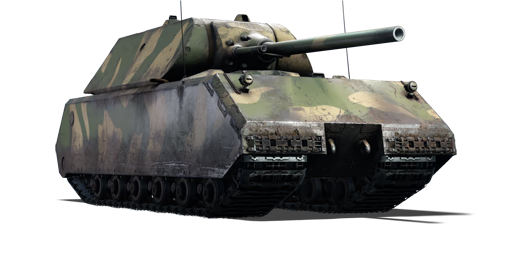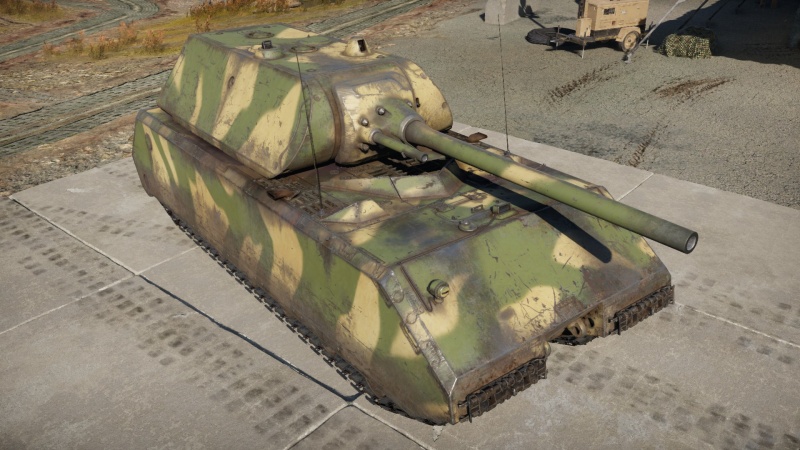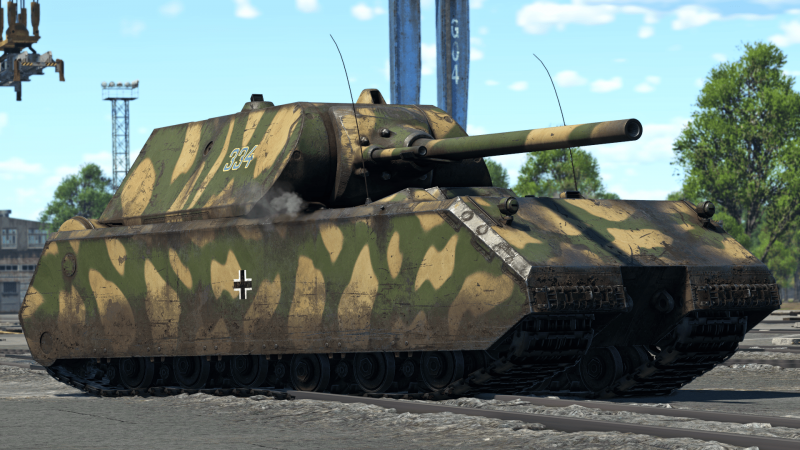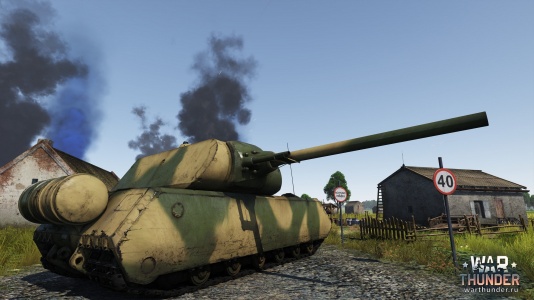Difference between revisions of "Maus"
m (Midpoint save (Work In Progress)) |
m (WIP edit) |
||
| Line 174: | Line 174: | ||
Yes, you heard that one right. While not ''strictly'' relegated to only flanking, this playstyle is more solitary and generally isn't tied to playing around your team. The disadvantages with this are obvious - if you take damage, you'll have to spend the full duration of the repair immobilized, and if you get overwhelmed by multiple enemies you won't be receiving much assistance if at all compared to playing around teammates. However, there is still most definitely a case to play on the less populated areas of the map as well. The most noticeable of these is definitely the fact that you'll be targeted by CAS far less often. Of course, if someone is intent on 'revenge bombing' your vehicle, you won't be safe from aerial threats, but against someone who dies in the main conflict zone of the match, it could be argued that the chances of being attacked are lower due to two reasons. The first is that those people can also go for their own 'revenge bombing' runs, which is certainly not you! The other is that in general, it's not so simple to find a good target from the air. In aircraft, the best indicator for an airstrike is a scouting marker, followed closely by teammates marking enemies on the map, large groups of enemies and people moving around the map quickly. As the Maus is so slow and in this case not near multiple teammates, it is simply less attractive to bomb and also not as apparent from the air compared to a hot zone of combat, which may definitely lead to better survivability. | Yes, you heard that one right. While not ''strictly'' relegated to only flanking, this playstyle is more solitary and generally isn't tied to playing around your team. The disadvantages with this are obvious - if you take damage, you'll have to spend the full duration of the repair immobilized, and if you get overwhelmed by multiple enemies you won't be receiving much assistance if at all compared to playing around teammates. However, there is still most definitely a case to play on the less populated areas of the map as well. The most noticeable of these is definitely the fact that you'll be targeted by CAS far less often. Of course, if someone is intent on 'revenge bombing' your vehicle, you won't be safe from aerial threats, but against someone who dies in the main conflict zone of the match, it could be argued that the chances of being attacked are lower due to two reasons. The first is that those people can also go for their own 'revenge bombing' runs, which is certainly not you! The other is that in general, it's not so simple to find a good target from the air. In aircraft, the best indicator for an airstrike is a scouting marker, followed closely by teammates marking enemies on the map, large groups of enemies and people moving around the map quickly. As the Maus is so slow and in this case not near multiple teammates, it is simply less attractive to bomb and also not as apparent from the air compared to a hot zone of combat, which may definitely lead to better survivability. | ||
| − | The other benefits include the unexpected nature of your position, as well as the various tools at your disposal. While 20.8 km/h is certainly not blisteringly fast, if left at this speed the Maus can most certainly reach common map positions not too long after your teammates. Most enemies you face on the flanks will be light tanks such as the [[BMP-1]] or thinly armored MBTs such as the [[AMX-30 (1972)]], and even if you face off against a MBT with more armor such as a [[T-55A]] you have the penetration to go through their turret cheeks and one shot them regardless. People generally gravitate towards the capture points and of those capture points usually a single one that's commonly fought over will attract most people, so you can surprisingly get around the enemy team with minimal resistance fairly often. If an enemy barrels your tank, use your 75 mm HEAT launcher to barrel and/or track them in return. If you see a [[M56]], [[JPz 4-5]] or other lightly armored SPAAs and light tank/TDs, use your HEAT rounds to save a reload cycle on your main gun. If you have to traverse a heavily defended corridor, use your smoke shells to create confusion and uncertainty before you start advancing. If you're being overwhelmed, your reverse is as fast as your forwards speed so try and create more distance between you and your enemy as you retreat to a better position. As a whole, you possess a lot of utility due to the second gun and if you can utilize it effectively you can become a true one-man army | + | The other benefits include the unexpected nature of your position, as well as the various tools at your disposal. While 20.8 km/h is certainly not blisteringly fast, if left at this speed the Maus can most certainly reach common map positions not too long after your teammates. Most enemies you face on the flanks will be light tanks such as the [[BMP-1]] or thinly armored MBTs such as the [[AMX-30 (1972)]], and even if you face off against a MBT with more armor such as a [[T-55A]] you have the penetration to go through their turret cheeks and one shot them regardless. People generally gravitate towards the capture points and of those capture points usually a single one that's commonly fought over will attract most people, so you can surprisingly get around the enemy team with minimal resistance fairly often. If an enemy barrels your tank, use your 75 mm HEAT launcher to barrel and/or track them in return. If you see a [[M56]], [[JPz 4-5]] or other lightly armored SPAAs and light tank/TDs, use your HEAT rounds to save a reload cycle on your main gun. If you have to traverse a heavily defended corridor, use your smoke shells to create confusion and uncertainty before you start advancing. If you're being overwhelmed, your reverse is as fast as your forwards speed so try and create more distance between you and your enemy as you retreat to a better position. As a whole, you possess a lot of utility due to the second gun and if you can utilize it effectively you can become a true one-man army as you pressure the enemy's often undefended flanks. |
| − | + | '''General Playstyle''' | |
| + | |||
| + | Regardless of how you play the Maus, be it spearhead of pushes or as a one-man army, they both benefit heavily from the clever usage of your 75 mm secondary gun. You can for the most part forego the smoke grenades modification early on as you only get 6 charges total from a launcher affixed to the turret, compared to the dozens upon dozens of rounds you can load into the cannon. | ||
| + | For lot of your time is wasted turning, | ||
Versus heavy tanks, the Maus has all the advantages. While slower it can make up for this in close combat thanks to the good turn rate of both tracks and turret. Just quickly angle the Maus (both turret and hull) and you will turn it nearly invincible (be advised that HEAT shells can still penetrate the angled turret). Try angling the front drive wheel at the enemy tank and turn the turret so that the armour is at ~45 degrees to the enemy fire. The tanks that pose a threat are the [[M103]], the [[M48 Patton (Family)|M48]], the [[T-62 545 (China)|Chinese T-62]], the BMPs, the [[Object 120]], and basically every tank that has HEATFS, ATGM, or APFSDS rounds that can penetrate more than 320 mm of armour. One good strategy is to capture the objective and just defend it. This can be really helpful to the team. | Versus heavy tanks, the Maus has all the advantages. While slower it can make up for this in close combat thanks to the good turn rate of both tracks and turret. Just quickly angle the Maus (both turret and hull) and you will turn it nearly invincible (be advised that HEAT shells can still penetrate the angled turret). Try angling the front drive wheel at the enemy tank and turn the turret so that the armour is at ~45 degrees to the enemy fire. The tanks that pose a threat are the [[M103]], the [[M48 Patton (Family)|M48]], the [[T-62 545 (China)|Chinese T-62]], the BMPs, the [[Object 120]], and basically every tank that has HEATFS, ATGM, or APFSDS rounds that can penetrate more than 320 mm of armour. One good strategy is to capture the objective and just defend it. This can be really helpful to the team. | ||
Revision as of 06:25, 22 March 2024
Contents
Description
The Pz.Kpfw. VIII Maus is a rank V German heavy tank with a battle rating of 8.0 (AB) and 7.7 (RB/SB). It was introduced in Update 1.47 "Big Guns" as a main tree vehicle, however in Update 1.91 "Night Vision" it was shifted to a gift vehicle for players who previously owned it. It was later available for research for a limited time during War Thunder's 8th, 9th, 10th and 11th anniversary events. The Maus is the epitome of the word 'heavy tank' and as such sports one of the thickest raw armor values in the game, alongside a monstrous weight of 188 tons and the size to show for it. The vehicle has various tools to spearhead a charge and lead your team to victory, but if positioned incorrectly or if the tools it has are underutilized players will quickly find that the Maus isn't as easygoing as its armor may suggest.
The Maus is more than just a mobile pillbox - its size and armor commandeer the term 'mobile bunker' instead. The 12.8 mm cannon on the Maus has devastating effectiveness, with options between a higher-filler, lower penetrating round and the 12.8/8.8 APHEDS round which has over 300 mm of flat penetration and flies a good 300m/s faster than the prior round. The vehicle's mobility is limited by the transmission to 20.8km/h both forwards and backwards, meaning careful planning of the vehicle's path is crucial to avoid downtime by trying to turn the hull. Armor is by far the most notable trait of the vehicle, but with a catch - the Maus straddles the line between Cold War and World War 2 vehicles, and as such the armor can swing wildly between not stopping any rounds or bouncing every enemy shell off the front. Careful positioning and planning is required to excel in the Maus, but if one takes the time to master it it can be nigh impossible to take down outside of a concerted team effort to take it down.
General info
Survivability and armour
Armour type:
- Rolled homogeneous armour
- Cast homogeneous armour (Gun mantlet)
| Armour | Front | Sides | Rear | Roof |
|---|---|---|---|---|
| Hull | 200 mm (55°) Front glacis 200 mm (35°) Lower glacis |
180 mm Top 100 mm Bottom 300 mm Weld joints |
150 mm (36°) Top 150 mm (31°) Bottom |
50 mm General area 100 mm Front roof |
| Turret | 232 mm (3-53°)Turret front 240 mm Gun mantlet |
205 mm (30°) | 200 mm (15°) | 60 mm |
Notes:
- The armour on the Maus is quite complex, and definitely does not end with the above-mentioned values
- Gun mantlet is 240 mm thick and nicely rounded, right around both guns the armour is 300 mm thick
- Tracks at the front are protected by 100+60 mm plates (100 mm basic plate + attached tracks)
- Behind the frontal upper plate on deck armour, there are many 60 mm highly sloped plates of armour, protecting the engine vents and turret ring from HEAT/HE shells and some small-calibre fire
- Frontal part of the belly is also 100 mm thick, with the rest being 50 mm
- Deck armour in front of these plates is also strengthened to an impressive 100 mm
- Side armour is split to two parts, top with 180 mm and bottom with 100 mm + tracks
- Even inside the tank there is armour - there are many 20 mm plates inside the tank, separating crew compartments from various modules, and partially protecting the interior from shrapnel that penetrated the tank from other areas
- One plate is at the rear of the tank, between the enormous transmission and the fighting compartment
- The second plate is more to the front, separating fighting compartment from the middle-mounted Engine and its radiators
- The third plate is in the front between the driver's compartment and the engine
- Around the driver there are many more 20 mm plates, adding some protection to fuel tanks located there
Mobility
The Maus weighs 188 tons. This is more than twice the weight of similar vehicles like it, such as the T95, TOG II, M103 or even the M1 Abrams, and it shows in the tank's mobility. The Maus tops out at a fairly slow 20.8 km/h in both forwards and reverse speed, which is enabled by its electric transmission, although it can easily reach and stay at this speed across most terrain due to strong torque. The tank slows down noticeably when turning, so if the player wishes to reach destinations at a brisker pace it is advised to minimize the number of turns needed to get to a point of interest.
| Game Mode | Max Speed (km/h) | Weight (tons) | Engine power (horsepower) | Power-to-weight ratio (hp/ton) | |||
|---|---|---|---|---|---|---|---|
| Forward | Reverse | Stock | Upgraded | Stock | Upgraded | ||
| Arcade | 22 | 22 | 188 | 1,549 | 2,290 | 8.24 | 12.18 |
| Realistic | 21 | 21 | 1,061 | 1,200 | 5.64 | 6.38 | |
Modifications and economy
Armaments
Main armament
| 128 mm KwK44 | Turret rotation speed (°/s) | Reloading rate (seconds) | |||||||||||
|---|---|---|---|---|---|---|---|---|---|---|---|---|---|
| Mode | Capacity | Vertical | Horizontal | Stabilizer | Stock | Upgraded | Full | Expert | Aced | Stock | Full | Expert | Aced |
| Arcade | 68 | -7°/+23° | ±180° | N/A | 6.6 | 9.0 | 10.9 | 12.0 | 12.8 | 23.66 | 20.93 | 19.30 | 18.20 |
| Realistic | 4.8 | 5.6 | 6.8 | 7.5 | 8.0 | ||||||||
Ammunition
| Penetration statistics | |||||||
|---|---|---|---|---|---|---|---|
| Ammunition | Type of warhead |
Penetration @ 0° Angle of Attack (mm) | |||||
| 10 m | 100 m | 500 m | 1,000 m | 1,500 m | 2,000 m | ||
| Sprgr. L/5 | HE | 37 | 37 | 37 | 37 | 37 | 37 |
| PzGr | APC | 252 | 249 | 237 | 222 | 208 | 195 |
| PzGr 43 | APCBC | 272 | 269 | 257 | 242 | 228 | 215 |
| 12,8/8,8 Pzgr.TS | APCBC | 312 | 307 | 288 | 266 | 245 | 226 |
| Shell details | ||||||||||||
|---|---|---|---|---|---|---|---|---|---|---|---|---|
| Ammunition | Type of warhead |
Velocity (m/s) |
Projectile mass (kg) |
Fuse delay (m) |
Fuse sensitivity (mm) |
Explosive mass (TNT equivalent) (g) |
Ricochet | |||||
| 0% | 50% | 100% | ||||||||||
| Sprgr. L/5 | HE | 750 | 28 | 0 | 0.1 | 3,700 | 79° | 80° | 81° | |||
| PzGr | APC | 930 | 26.35 | 1.2 | 19 | 786.5 | 48° | 63° | 71° | |||
| PzGr 43 | APCBC | 940 | 28.3 | 1.2 | 19 | 786.5 | 48° | 63° | 71° | |||
| 12,8/8,8 Pzgr.TS | APCBC | 1,230 | 9.85 | 1.2 | 19 | 108.8 | 48° | 63° | 71° | |||
Ammo racks
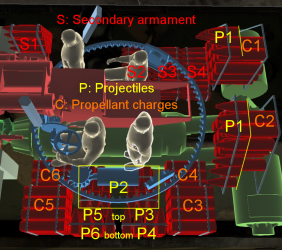
| Full ammo |
Ammo parts |
1st rack empty |
2nd rack empty |
3rd rack empty |
4th rack empty |
5th rack empty |
6th rack empty |
Visual discrepancy |
|---|---|---|---|---|---|---|---|---|
| 68 | Projectiles Propellants |
55 (+13) 57 (+11) |
33 (+35) 45 (+23) |
25 (+43) 37 (+31) |
17 (+51) 23 (+45) |
9 (+59) 15 (+53) |
1 (+67) 1 (+67) |
No |
Notes:
- The Maus uses two-piece ammunition, composed of projectiles (yellow) and propellant charges (orange). Both have separate racks.
- Projectiles and propellants are modeled by sets of 2 which disappear once both in the set have been fired.
- Turret empty: 45 (+23) shells.
Additional armament
The Maus comes equipped with what is ostensibly the main gun of low tier German vehicles - the 75 mm cannon. While the gun is technically slightly different with it being a L/36.5 and not a L/37, performance is near identical. This 75 mm unlike other coaxial guns on other heavy tanks such as the M6A1/T1E1 has significant utility and without it the Maus would be far worse off. This utility includes being able to quickly load and fire HEAT shells at flanking open top or light vehicles to overpressure them, track or barrel enemies that barrel your main gun and try to push up to you, and creating what is basically a smoke wall by firing smoke rounds in succession as you advance to cover potentially lethal corridors.
| 75 mm KwK44 L/36.5 | Reloading rate (seconds) | ||||||
|---|---|---|---|---|---|---|---|
| Capacity | Vertical | Horizontal | Stabilizer | Stock | Full | Expert | Aced |
| 100 | N/A | N/A | N/A | 5.20 | 4.60 | 4.24 | 4.00 |
Ammunition
| Penetration statistics | |||||||
|---|---|---|---|---|---|---|---|
| Ammunition | Type of warhead |
Penetration @ 0° Angle of Attack (mm) | |||||
| 10 m | 100 m | 500 m | 1,000 m | 1,500 m | 2,000 m | ||
| Sprgr. 34 | HE | 10 | 10 | 10 | 10 | 10 | 10 |
| Hl.Gr 38B | HEAT | 80 | 80 | 80 | 80 | 80 | 80 |
| Hl.Gr 38C | HEAT | 115 | 115 | 115 | 115 | 115 | 115 |
| Shell details | ||||||||||||
|---|---|---|---|---|---|---|---|---|---|---|---|---|
| Ammunition | Type of warhead |
Velocity (m/s) |
Projectile mass (kg) |
Fuse delay (m) |
Fuse sensitivity (mm) |
Explosive mass (TNT equivalent) (g) |
Ricochet | |||||
| 0% | 50% | 100% | ||||||||||
| Sprgr. 34 | HE | 420 | 5.74 | 0.2 | 0.1 | 686 | 79° | 80° | 81° | |||
| Hl.Gr 38B | HEAT | 450 | 4.4 | 0.05 | 0.1 | 872.1 | 62° | 69° | 73° | |||
| Hl.Gr 38C | HEAT | 450 | 4.8 | 0.05 | 0.1 | 875.5 | 62° | 69° | 73° | |||
| Smoke shell characteristics | ||||||
|---|---|---|---|---|---|---|
| Ammunition | Velocity (m/s) |
Projectile mass (kg) |
Screen radius (m) |
Screen deploy time (s) |
Screen hold time (s) |
Explosive mass (TNT equivalent) (g) |
| K.Gr.Rot Nb. | 423 | 6.2 | 9 | 5 | 20 | 50 |
Ammo racks

| Full ammo |
1st rack empty |
2nd rack empty |
3rd rack empty |
4th rack empty |
Visual discrepancy |
|---|---|---|---|---|---|
| 100 | 76 (+24) | 51 (+49) | 26 (+74) | 1 (+99) | No |
Notes:
- Racks are modelled by sets of 5 shells. The sets disappear from the rack once all shells in the set have been loaded/fired.
- Turret empty: 76 (+24) shells.
Machine guns
| 7.92 mm MG34 | ||||
|---|---|---|---|---|
| Mount | Capacity (Belt) | Fire rate | Vertical | Horizontal |
| Coaxial | 1,000 (150) | 900 | -7°/+23° | N/A |
Usage in battles
Pros:
- Heavily-armoured tank, practically invincible if angled properly
- Capable of soaking a large amount of damage and very resilient to bombs and rockets
- Only vulnerable to large-calibre HE shells
- Turret sides are as strong as, if not stronger than, the front of the turret
- Access to smoke grenades
- Surprisingly good off-road manoeuvrability
- Makes decently fast turns in high gear movement or in neutral steering
- Very difficult to immobilize, due to extremely thick track skirts
- Powerful 128 mm cannon and rounds
- Secondary 75 mm coaxial cannon is surprisingly effective when using HEAT rounds
- Has commander sights, useful for looking around without moving the turret
Cons:
- Very slow
- Struggles on hilly terrain
- Requires good teamwork to perform adequately
- Slow turret rotation
- The sides of the Maus are littered with ammo racks
- Very loud engine, players will be able to locate the Maus just by the engine sounds
- Vulnerable at all ranges to modern rounds such as HEAT and sabot rounds
- Towing is practically impossible unless it is done by another Maus
- Large bombs will commonly cripple the Maus, or detonate its fuel tanks
- Optics have little zoom capability, making it difficult for hitting long range targets
- Big target for ATGMs
- No modern armour of any kind, relies completely on conventional armour plating
- Secondary 75 mm is hard to aim
- Commander sight does not allow for commander aiming
History
Development
This monster of a tank started development in 1942 on the suggestion of Ferdinand Porsche to Hitler, which was approved. The first prototype was to be completed by 1943 and the project vehicle was designated the Mammut (Mammoth). The name changed in December 1942 to Mäuschen (Little Mouse), then once more to the Maus (Mouse) in February 1943, which stayed as its designation (and perhaps proving that Germany does have a sense of humour).
The prototype used Ferdinand's "electric transmission" that was previously used on the rejected Tiger(P), the vehicle would be powered by an MB 517 diesel engine. The Maus has a suspension design with 24 wheels on each side, 2 per bogie with two bogies side by side and six bogies lining up from front and back. The armour was perhaps the most defining feature at 220 mm thick at the hull front, the sides and rear were 190 mm thick. The turret was even thicker at 240 mm on the front and 200 mm on the sides and rear. The vehicle was to also have a 128 mm KwK44 main gun with a 75 mm KwK44 gun as a coaxial. The overwhelming design was approximated to weight 100 tons.
The production plan was to have the prototype completed by mid-1943 and for 10 vehicles per month after the prototype delivery. Work would be divided between Krupp and Alkett for the production of the machine. The wooden model of the tank was presented on May 1943 to Hitler. It was then approved for production and 150 of them were to be built. With the final design finished, it was estimated to weight 188 tons now. Though Hitler and his peers saw it with much favour, Heinz Guderian criticised the Maus design because there was a lack of machine guns, thus it was extremely vulnerable to infantry attacks at close-quarters for the same reason as the Ferdinand tank destroyer. The anti-infantry problem was solved with the addition of a coaxial machine gun and a "Nahverteidigungswaffe" dischargers, firing smoke or high-explosive shells in its surrounding area, installed on the turret.
Production and cancellation
Two prototypes of the Maus were made in 1943 and 1944. The first one, called V1 was turretless and assembled by Alkett in December 1943, it was fitted with a mock turret that helped finalise the turret design in 1944. Here they determine the Maus was definitely too heavy for any bridges in existence so the Maus would ford rivers with a snorkel. The second prototype called V2 by Alkett again had the first produced Maus turret attached with the 128 mm gun, coaxial 75 mm gun, and coaxial machine gun. In July 1944, Krupp was producing four more hulls, but these were scrapped and the whole project stopped on August 1944, though tests with the V2 continued. The weight of the tank meant that the power-to-weight ratio was extremely poor, resulting in the Maus' ideal speed of about 8 miles per hour maximum in ideal conditions.
However, the Maus was never fully produced because it was the only tank that ceased production because of a strategic bombing campaign that would ruin its production facilities. Adding to this, by 1944, the Red Army was advancing deeper and deeper into what was previously German-controlled territory. The vision that the Red Army might capture the testing grounds of the Maus prototypes and the prototypes themselves seem to come closer to reality. The Germans were forced to destroy the prototypes to prevent their capture by the Soviets, placing charges onto the V2 prototype (the V1 was only a hull so it wasn't combat-effective). The second prototype had the entire hull damaged as there was ammunition still in the tank when the charges went off, but the turret was mostly intact. The Soviets captured the damaged prototypes and held them until the end of the war. After World War II, the Soviet Commander of Armoured and Mechanized troops ordered for the V1 hull to be attached with the turret from the V2 prototype. They had to use six Sd.Kfz. 9, the largest half-track vehicles produced by Germany, to move the 55-ton turret to the hull. The fixed prototype was sent back to the Soviet Union for testing and arrive on May 4, 1946. Once this is done, the prototype was sent to Kubinka Tank museum in Russia where it lays today on display for the public.
| Archive of the in-game description | |
|---|---|
|
An experimental super-heavy tank built in Germany towards the end of the war. The project was developed by Ferdinand Porsche. The first tank was assembled at the Alkett factory in Berlin on August 1, 1943. The first trial run of the Type 205/1 tank was conducted on December 24, 1943. The turret still wasn't ready, so a load equal to the weight of the turret was placed on top of the tank. The prototype turned out to be quite manoeuvrable once it was able to leave the assembly area, where it had been rather cramped. According to those who had the opportunity to drive the tank, the Maus was easier to drive than the Pz.Kpfw. IV. In November, 1943 a 44 calibre, 128 mm KwK44 cannon was built that was intended for the tank. The cannon's designation was later changed to 12.8 cm KwK82. The weapon was tested at the Meppen training ground. The turret was installed on the 205/1 prototype on July 6, 1944, and on October 3, 1944 the armament was installed and the fully-outfitted tank was tested at the training ground in Kummersdorf. Both prototypes were tested in Kummersdorf, but no reliable information on these tests is available. Whether or not experimental firing was conducted is also unknown. Toward the end of the war, bodies and turrets had begun to be produced in addition to the prototypes that had been built. As the Soviet troops were approaching in 1945 both prototypes were blown up. Soviet specialists were able to reconstruct one Maus from the wreckage. This rebuilt tank was delivered to the training ground in Kubinka in 1946, where various tests were performed. The Panzerkampfwagen Maus can currently be viewed on display at the tank museum in Kubinka. | |
Media
- Skins
- Images
- Videos
See also
Links to the articles on the War Thunder Wiki that you think will be useful for the reader, for example:
- reference to the series of the vehicles;
- links to approximate analogues of other nations and research trees.
External links
- [Devblog] Panzerkampfwagen VIII «Maus»
- [Historical] Panzerkampfwagen VIII "Maus", Part I, Part II, and Part III
| Germany heavy tanks | |
|---|---|
| Tiger 1 (Henschel) | Tiger H1 · Tiger E · ␠Tiger |
| Tiger 1 (Porsche) | VK 45.01 (P) · Pz.Bef.Wg.VI P |
| Tiger 2 | Tiger II (P) · Tiger II (H) · Tiger II (H) Sla.16 · Tiger II (10.5 cm Kw.K) |
| Super heavy tanks | Maus · E-100 |
| Trophies | |
| Great Britain | ▀Pz.Kpfw. Churchill |
| USSR | ▀KV-IB · ▀KW I C 756 (r) · ▀KW II 754 (r) |


